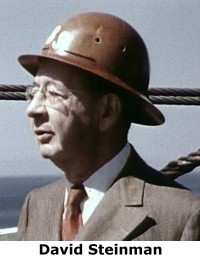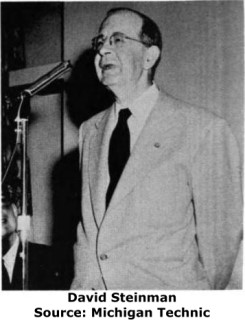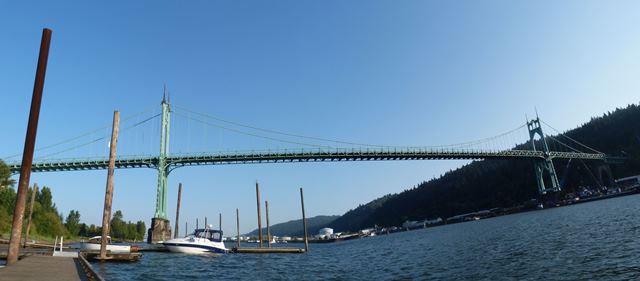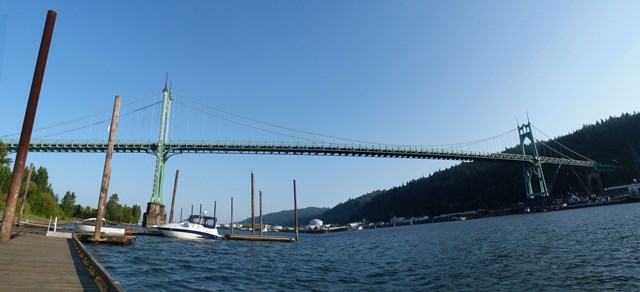We Recommend:
Bach Steel - Experts at historic truss bridge restoration.
BridgeHunter.com Phase 1 is released to the public! - Visit Now
St. Johns Bridge

Primary Photographer(s): Nathan Holth
Bridge Documented: August 23, 2014
Portland: Multnomah County, Oregon: United States
Metal Pony Truss Stiffening Wire Cable Suspension, Fixed and Approach Spans: Metal Rivet-Connected Warren Deck Truss, Fixed
1931 By Builder/Contractor: Wallace Bridge and Structural Steel Company of Seattle, Washington and Engineer/Design: Robinson and Steinman of New York, New York
2005
1,207.0 Feet (367.9 Meters)
3,608.8 Feet (1100 Meters)
40 Feet (12.19 Meters)
3 Main Span(s) and 12 Approach Span(s)
649712300091

View Information About HSR Ratings
Bridge Documentation
View Archived National Bridge Inventory Report - Has Additional Details and Evaluation
View Historic American Engineering Record (HAER) Documentation For This Bridge
HAER Data Pages, PDF - HAER Drawings, PDF - HAER Data Pages Addendum, PDF
HAER Documentation, Willamette River Bridges - Data Pages - Drawings -Timeline
View Historic Resource Inventory Sheet For This Bridge
View Historical Articles About This Bridge
This iconic bridge is one of the most famous bridges in Oregon because of its incredible beauty and historic significance. It was designed by Robinson and Steinman. David Steinman was one of the most famous bridge engineers of the 20th Century and he specialized in design of suspension bridges.
The history of this bridge is well documented, so be sure to view the HAER documentation that tells the general history of the bridge. Because the bridge is well documented in other sources, the HistoricBridges.org narrative here is intended to focus on some features and history of the bridge that might be overlooked in the larger more comprehensive histories of the bridge.
When this bridge completed, this bridge had the longest span of any suspension bridge west of the Ambassador Bridge in Detroit. The concrete piers of the bridge are unusual for the period in which they were built because they contain solid steel frame reinforcement rather than just reinforcing rods (rebar) which was common during this period.
Wallace Bridge and Structural Steel Company was listed as the fabricator of the steel superstructure, and construction of the superstructure was shared by subsidiaries of U.S. Steel, U.S. Steel Products Company and Columbia Steel Company. The deck stringers were fabricated by Willamette Iron and Steel Works of Portland. J. H. Pomeroy Company erected the steel for the bridge.
Arguably one of the most beautiful bridges in the country, this bridge embodies the pinnacle of bridge aesthetics. Its beauty is solely derived from creating structural bridge elements that are themselves beautiful rather than adding superficial decorations to an ugly bridge structure. For example, the distinctive gothic arches in the piers and steel suspension towers of this bridge are attractive, but they also function as part of the actual structure and contribute to the strength and stability of the bridge. The concrete anchorages on this bridge are magnificent works of art... the only other anchorages that come to mind with a similar level of aesthetics are those for the Benjamin Franklin Bridge. The concrete foundations for the main suspension towers are also rather elaborate in architectural detailing.
The concept of making the actual bridge structure beautiful is rarely seen in modern bridge construction today, which has returned to the less sophisticated and less attractive concept of adding superficial decorations to bridge structures that are typically uglier than any bridge every built in the history of humanity. Moreover, adding these superficial decorations to modern bridges is only occasionally done and is given a special term called "context sensitive design" which is the polite way of saying "put pretty little decorations on our hideously ugly bridge." This modern practice only makes bridges like the St. Johns Bridge stand out as increasingly rare and significant.
David Steinman was known for suggesting the paint color that would look best on the bridges he designed. He did this for his Mackinac Bridge and also for the St. Johns Bridge. When the paint color of the bridge was being chosen, safety advocates wanted the tall bridge to be painted in stripes of bright yellow and black for airplanes. It is not known why anyone would suggest this given that lights on the towers is the traditional way of warning aircraft of tall structures. There is no record of any bridge in the United States being painted a particular color to warn airplanes. Fortunately, this idea was not selected for the St. Johns Bridge either, and David Steinman's suggestion of verde green to blend in with the trees was chosen. Steinman had a very sensible view on bridge paint color. He disliked the black and grey paint that was typical for bridges. He was quoted as saying he wanted "to get away from these sad, somber, cold colors and into something warm and bright to harmonize with and be apart of the landscape."
From a photography standpoint, these colors that Steinman advocated are also preferable because it makes the bridge easier to photograph in cloudy, dark weather, and also brings out the details and complexity that distinguish historic bridges from modern bridges.
Information and Findings From Oregon's Historic Bridge InventoryDescription 1207-ft steel suspension main span with riveted steel deck truss approach spans for a total length of 3608-ft. Designer David B. Steinman and Holton D. Robinson Builders Gilpin Construction (Contractor), John A. Roebling's Sons Co. (Cable Design/Fabrication), Lindstrom and Feigenson (Contractor), Wallace Bridge and Structural Steel Company (Steel Fabricator) Significance As the largest and earliest of Oregon's three extant suspension bridges, the St. Johns Bridge is one of the most significant structures in the state. The designer, internationally-famous David B. Steinman, identified this bridge as his favorite among all those he built. Innovative for its time, it featured the highest concrete rigid frame piers in the world, the first use of main steel towers without diagonal bracing, and the use of prestressed rope strands instead of the conventional parallel wire cable construction. It also incorporated a number of decorative features, including its gothic arched details, large copper spires, a decorative steel railing and ornamentation on the concrete piers. The gothic arched details of this bridge may have influenced McCullough's later bridge designs. Character Defining Features Structure type, Location, Decorative details, Railing, Nameplate, Distinctive color Alterations A significant rehabilitation was completed in 2005. Bridge Considered Historic By Survey: Yes |
![]()
Photo Galleries and Videos: St. Johns Bridge
Structure Overview
Original / Full Size PhotosA collection of overview photos that show the bridge as a whole and general areas of the bridge. This gallery offers photos in the highest available resolution and file size in a touch-friendly popup viewer.
Alternatively, Browse Without Using Viewer
![]()
Structure Details
Original / Full Size PhotosA collection of detail photos that document the parts, construction, and condition of the bridge. This gallery offers photos in the highest available resolution and file size in a touch-friendly popup viewer.
Alternatively, Browse Without Using Viewer
![]()
Structure Overview
Mobile Optimized PhotosA collection of overview photos that show the bridge as a whole and general areas of the bridge. This gallery features data-friendly, fast-loading photos in a touch-friendly popup viewer.
Alternatively, Browse Without Using Viewer
![]()
Structure Details
Mobile Optimized PhotosA collection of detail photos that document the parts, construction, and condition of the bridge. This gallery features data-friendly, fast-loading photos in a touch-friendly popup viewer.
Alternatively, Browse Without Using Viewer
![]()
CarCam: Southwestbound Crossing
Full Motion VideoNote: The downloadable high quality version of this video (available on the video page) is well worth the download since it offers excellent 1080 HD detail and is vastly more impressive than the compressed streaming video. Streaming video of the bridge. Also includes a higher quality downloadable video for greater clarity or offline viewing.
![]()
Maps and Links: St. Johns Bridge
Coordinates (Latitude, Longitude):
Search For Additional Bridge Listings:
Bridgehunter.com: View listed bridges within 0.5 miles (0.8 kilometers) of this bridge.
Bridgehunter.com: View listed bridges within 10 miles (16 kilometers) of this bridge.
Additional Maps:
Google Streetview (If Available)
GeoHack (Additional Links and Coordinates)
Apple Maps (Via DuckDuckGo Search)
Apple Maps (Apple devices only)
Android: Open Location In Your Map or GPS App
Flickr Gallery (Find Nearby Photos)
Wikimedia Commons (Find Nearby Photos)
Directions Via Sygic For Android
Directions Via Sygic For iOS and Android Dolphin Browser
USGS National Map (United States Only)
Historical USGS Topo Maps (United States Only)
Historic Aerials (United States Only)
CalTopo Maps (United States Only)









